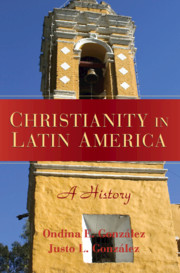Book contents
- Frontmatter
- Contents
- Preface
- Introduction
- 1 Foundations
- 2 The Arrival of Christianity
- 3 The Shaping of the Faith
- 4 Reform Movements
- 5 The Church in Turmoil
- 6 The Church's New Place
- 7 Protestant Immigration
- 8 An Expanding Protestant Presence
- 9 Catholicism after Vatican II
- 10 Pentecostalism and Autochthonous Movements
- 11 By Way of Conclusion
- Some Suggestions for Further Reading
- Sources Referenced
- Index
9 - Catholicism after Vatican II
Published online by Cambridge University Press: 05 June 2012
- Frontmatter
- Contents
- Preface
- Introduction
- 1 Foundations
- 2 The Arrival of Christianity
- 3 The Shaping of the Faith
- 4 Reform Movements
- 5 The Church in Turmoil
- 6 The Church's New Place
- 7 Protestant Immigration
- 8 An Expanding Protestant Presence
- 9 Catholicism after Vatican II
- 10 Pentecostalism and Autochthonous Movements
- 11 By Way of Conclusion
- Some Suggestions for Further Reading
- Sources Referenced
- Index
Summary
We must now continue the history of Roman Catholicism beyond the point at which we left it in Chapter 6 – just after the middle of the twentieth century. In the latter half of the twentieth century, there were in the Roman Catholic Church momentous changes that would be felt in Latin America and throughout the world. These changes were connected mostly with Pope John XXIII and the ecumenical council he convened, Vatican II. Roughly at the same time this council was convening, there were in Latin America serious and far-reaching discussions on poverty and its causes. Partly as a result of Vatican II, but also in continuation with earlier initiatives, the Consejo Episcopal Latinoamericano (Latin American Bishops' Council), commonly known as CELAM, was organized in 1966. Although issues of poverty and social justice were not originally a very high priority in its agenda, they became such in CELAM's second general session, held in Medellin, Colombia, in 1968, and simply known as Medellin. While most of its statements were fairly moderate, Medellin opened the way for base ecclesial communities (comunidades eclesiales de base, or CEBs) and for their concomitant liberation theology – both of which made a significant impact not only in Latin America but also throughout the world. All the foregoing had as its context the political polarization and violence that took place in Latin America as a reflection of the Cold War, and this polarization and other factors were tied to resistance and opposition to both CEBs and liberation theology.
- Type
- Chapter
- Information
- Christianity in Latin AmericaA History, pp. 240 - 269Publisher: Cambridge University PressPrint publication year: 2007



